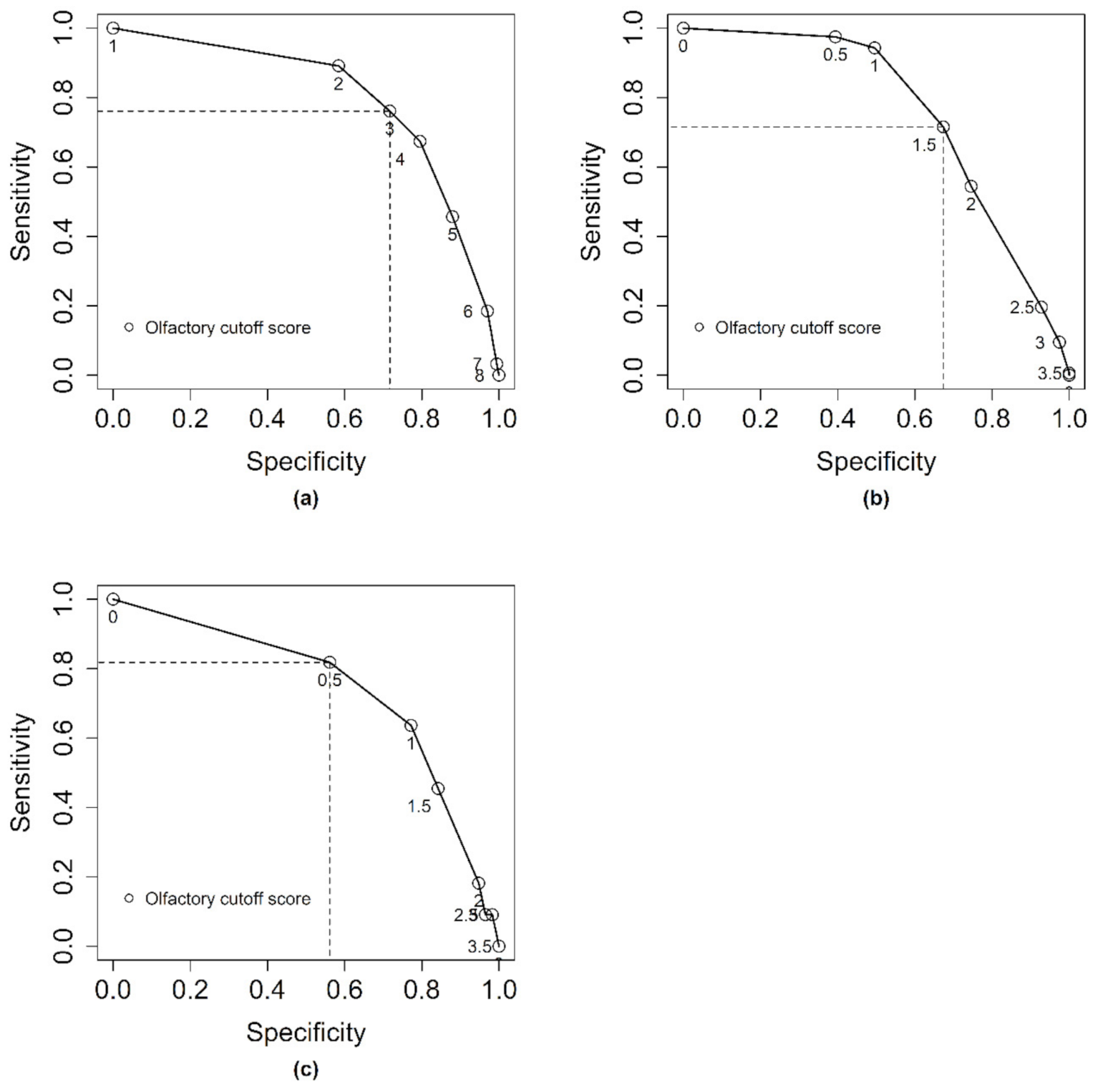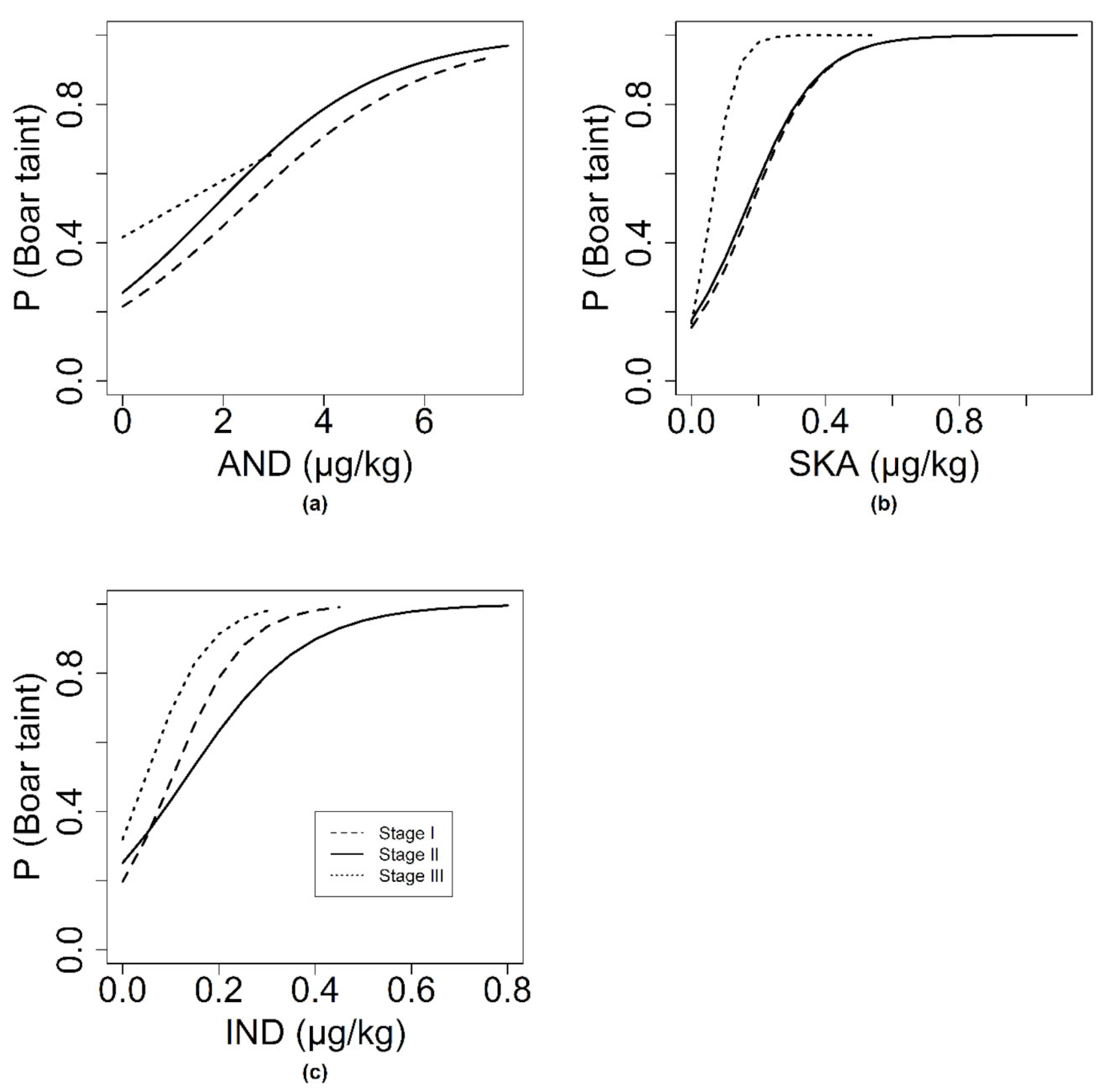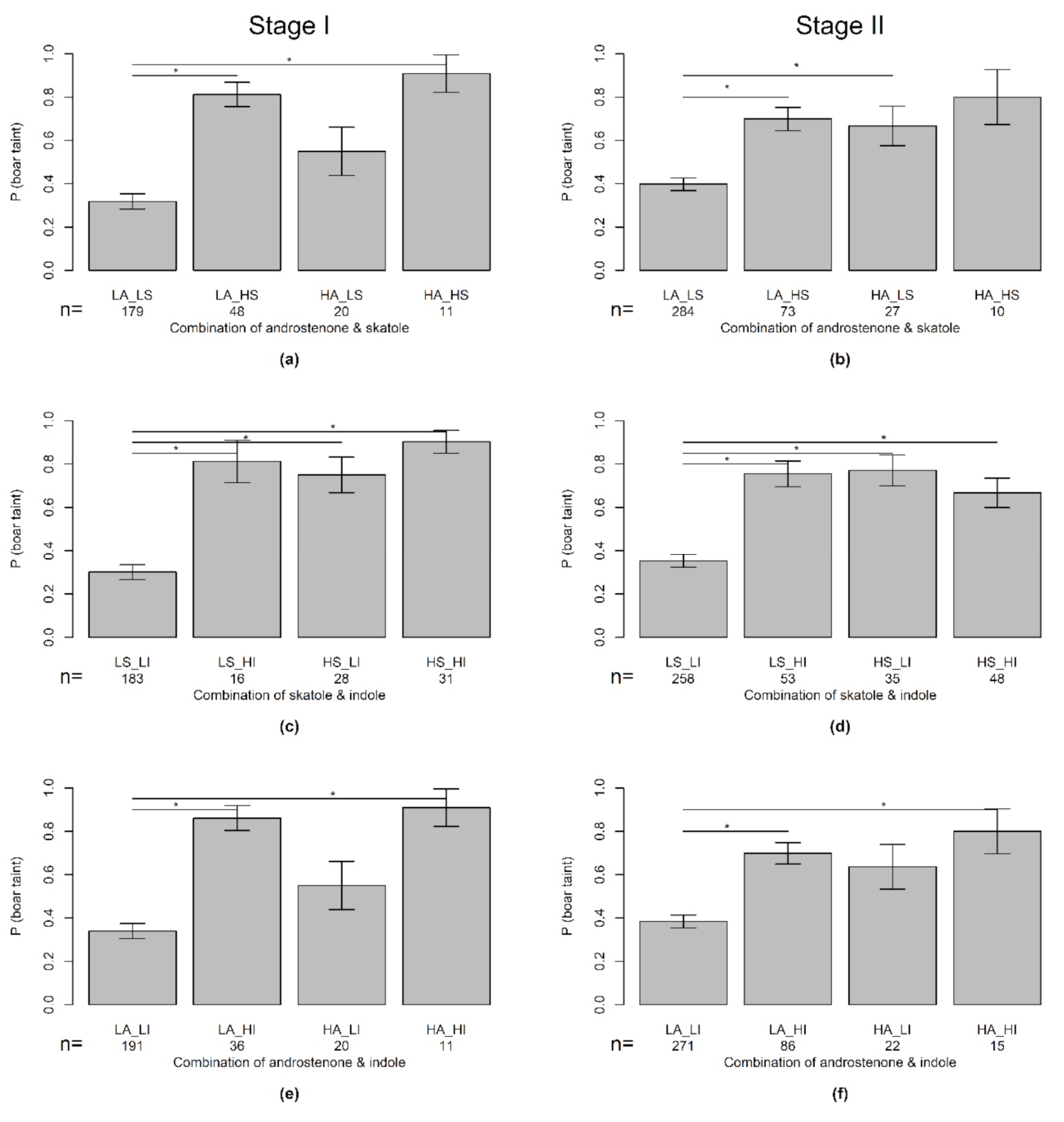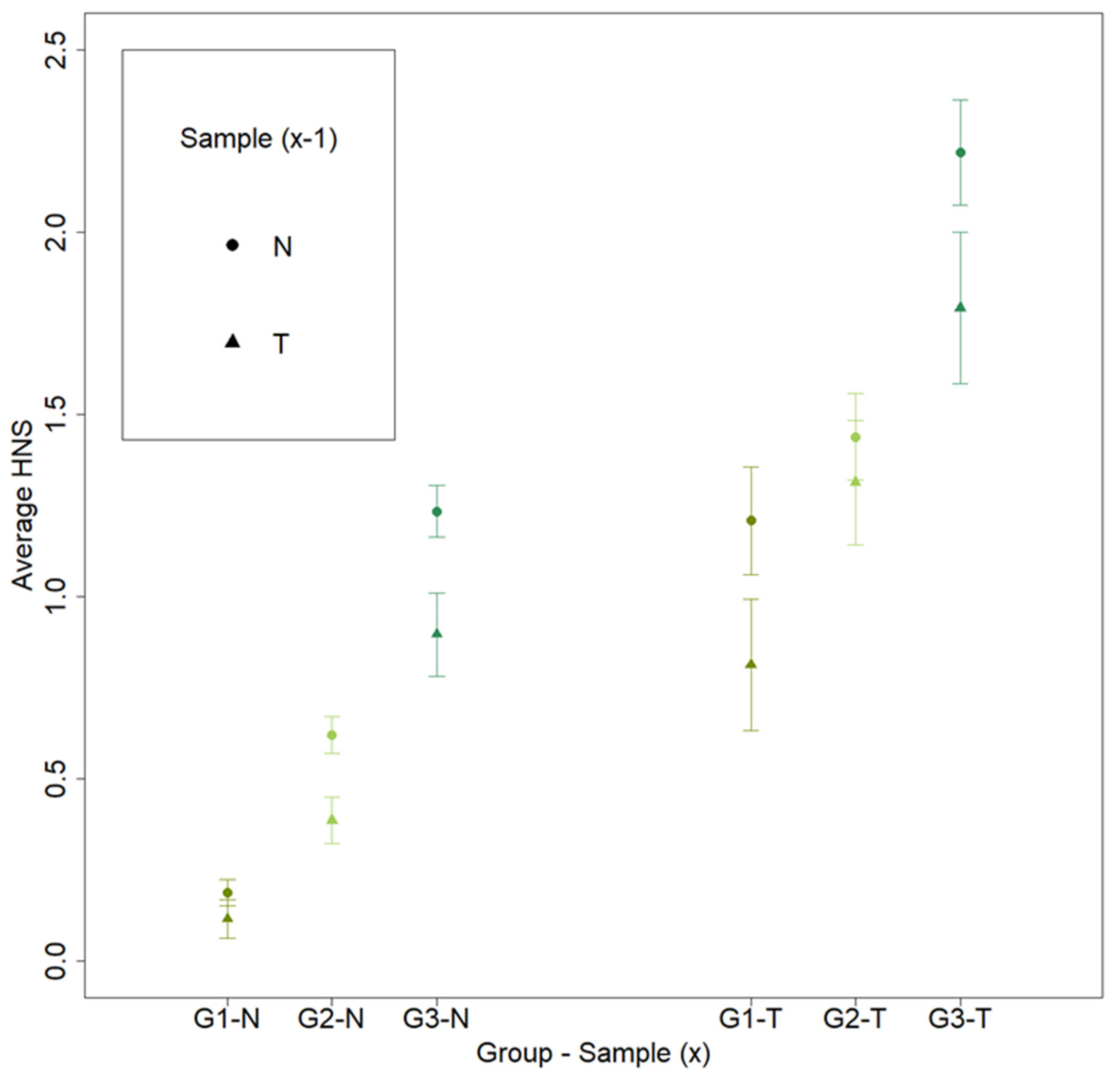Developing and Understanding Olfactory Evaluation of Boar Taint
Simple Summary
Abstract
1. Introduction
2. Materials and Methods
2.1. Training Protocol
2.1.1. Step 1: Selection
2.1.2. Step 2: Difference and Rank
2.1.3. Step 3: Introduction to Fat Samples
2.1.4. Step 4: 3-AFC Tests of Fat Samples
2.1.5. Step 5: Series of Fat Samples
2.2. Scoring Method
2.2.1. Stage I
2.2.2. Stage II
2.2.3. Stage III
2.3. Experiment 1: Effect of Familiarity and Previous Sample
2.3.1. Samples
2.3.2. Scoring and Scale
2.3.3. Participants
2.4. Experiment 2: Detection Threshold of AND, SKA, and IND
2.4.1. On Strips
2.4.2. In Fat
2.5. Experiment 3: Priming with Smell Strips and Time of Day
2.6. Data Analysis
2.6.1. Scoring Method
2.6.2. Experiment 1
2.6.3. Experiment 2
2.6.4. Experiment 3
3. Results
3.1. Scoring Method
3.1.1. ROC Curves to Determine a Cutoff Score
3.1.2. Relationship between Olfactory Score and Boar Taint Compounds
3.2. Experiment 1: Familiarity and Effect of Preceding Sample
3.3. Experiment 2: Detection Threshold AND, SKA, and IND
3.4. Experiment 3: Priming with Smell Strips
4. Discussion
5. Conclusions
Author Contributions
Funding
Acknowledgments
Conflicts of Interest
References
- Claus, R.; Weiler, U.; Herzog, A. Physiological aspects of androstenone and skatole formation in the boar—A review with experimental data. Meat Sci. 1994, 38, 289–305. [Google Scholar] [CrossRef]
- Moss, B.W.; Hawe, S.M.; Walker, N. Sensory Thresholds for Skatole and Indole; Colloques de l’INRA: Paris, France, 1993. [Google Scholar]
- Rius, M.; Garcia-RegueiroJ. Skatole and indole concentrations in Longissimus dorsi and fat samples of pigs. Meat Sci. 2001, 59, 285–291. [Google Scholar] [CrossRef]
- Trautmann, J.; Meier-Dinkel, L.; Gertheiss, J.; Mörlein, D. Boar taint detection: A comparison of three sensory protocols. Meat Sci. 2016, 111, 92–100. [Google Scholar] [CrossRef]
- Bremner, E.A.; Mainland, J.D.; Khan, R.M.; Sobel, N. The prevalence of androstenone anosmia. Chem. Senses 2003, 28, 423–432. [Google Scholar] [CrossRef] [PubMed]
- Bekaert, K.M.; Tuyttens, F.A.M.; Duchateau, L.; De Brabander, H.F.; Aluwé, M.; Millet, S.; VandenDriessche, F.; Vanhaecke, L. The sensitivity of Flemish citizens to androstenone: Influence of gender, age, location and smoking habits. Meat Sci. 2011, 88, 548–552. [Google Scholar] [CrossRef]
- Bonneau, M.; Kempster, A.J.; Claus, R.; Claudi-Magnussen, C.; Diestre, A.; Tornberg, E.; Walstra, P.; Chevillon, P.; Weiler, U.; Cook, G.L. An international study on the importance of androstenone and skatole for boar taint: I. Presentation of the programme and measurement of boar taint compounds with different analytical procedures. Meat Sci. 2000, 54, 251–259. [Google Scholar] [CrossRef]
- Hagen, D.R.; Mills, E.W.; Bryan, K.A.; Clark, A.M. Effects of exogenous porcine growth hormone (pGH) on growth, carcass traits, reproductive characteristics, and meat sensory attributes of young boars. J. Anim. Sci. 1991, 69, 2472–2479. [Google Scholar] [CrossRef] [PubMed]
- Mathur, P.K.; Napel, J.T.; Bloemhof, S.; Heres, L.; Knol, E.F.; Mulder, H.A. A human nose scoring system for boar taint and its relationship with androstenone and skatole. Meat Sci. 2012, 91, 414–422. [Google Scholar] [CrossRef] [PubMed]
- Meier-Dinkel, L.; Sharifi, A.R.; Tholen, E.; Frieden, L.; Bücking, M.; Wicke, M.; Mörlein, D. Sensory evaluation of boar loins: Trained assessors’ olfactory acuity affects the perception of boar taint compounds. Meat Sci. 2013, 94, 19–26. [Google Scholar] [CrossRef] [PubMed]
- Whittington, F.M.; Zammerini, D.; Nute, G.R.; Baker, A.; Hughes, S.; Wood, J.D. Comparison of heating methods and the use of different tissues for sensory assessment of abnormal odours (boar taint) in pig meat. Meat Sci. 2011, 88, 249–255. [Google Scholar] [CrossRef]
- Mörlein, D.; Meier-Dinkel, L.; Moritz, J.; Sharifi, A.R.; Knorr, C. Learning to smell: Repeated exposure increases sensitivity to androstenone, a major component of boar taint. Meat Sci. 2013, 94, 425–431. [Google Scholar] [CrossRef] [PubMed]
- Furnols, M.F.I.; Guerrero, L.; Serra, X.; Rius, M.À.; Oliver, M.À. Sensory characterization of boar taint in entire male pigs. J. Sens. Stud. 2000, 15, 393–409. [Google Scholar] [CrossRef]
- Trautmann, J.; Gertheiss, J.; Wicke, M.; Mörlein, D. How olfactory acuity affects the sensory assessment of boar fat: A proposal for quantification. Meat Sci. 2014, 98, 255–262. [Google Scholar] [CrossRef] [PubMed]
- Heyrman, E.; Millet, S.; Tuyttens, F.A.M.; Ampe, B.; Janssens, S.; Buys, N.; Wauters, J.; Vanhaecke, L.; Aluwé, M. Olfactory evaluation of boar taint: Effect of factors measured at slaughter and link with boar taint compounds. Animal 2017, 11, 2084–2093. [Google Scholar] [CrossRef] [PubMed]
- Heyrman, E.; Millet, S.; Tuyttens, F.; Ampe, B.; Janssens, S.; Buys, N.; Wauters, J.; Vanhaecke, L.; Aluwé, M. Aggression, stress, leanness, feed, and their relation to boar taint. In Proceedings of the Book of Abstracts of the 68th Annual Meeting of the European Association for Animal Production, Tallinn, Estonia, 28 August–1 September 2017; Wageningen Academic Publishers: Wageningen, The Netherlands, 2017; p. 218. [Google Scholar]
- Heyrman, E.; Millet, S.; Tuyttens, F.; Ampe, B.; Janssens, S.; Buys, N.; Wauters, J.; Vanhaecke, L.; Aluwé, M. On farm intervention studies on reduction of boar taint prevalence: Feeding strategies, presence of gilts and time in lairage. Res. Veter. Sci. 2018, 118, 508–516. [Google Scholar] [CrossRef] [PubMed]
- Bekaert, K.M.; Bussche, J.V.; François, S.; Tuyttens, F.A.M.; De Brabander, H.F.; VandenDriessche, F.; Vanhaecke, L. A validated ultra-high performance liquid chromatography coupled to high resolution mass spectrometry analysis for the simultaneous quantification of the three known boar taint compounds. J. Chromatogr. A 2012, 1239, 49–55. [Google Scholar] [CrossRef] [PubMed]
- ASTM. Standard practice for determining odor and taste thresholds by a forced-choice ascending concentration series method of limits, E-679-04. Annu. Book Stand. 2008, 15, 36–42. [Google Scholar]
- Loong, T. Clinical review Understanding sensitivity and specificity with the right. BMJ 2003, 327, 716–719. [Google Scholar] [CrossRef]
- Lawless, H.T.; Heymann, H. Sensory Evaluation of Food: Principles and Practices; Springer Science and Business Media LLC: Bazel, Switzerland, 2010. [Google Scholar]
- Meier-Dinkel, L.; Gertheiss, J.; Müller, S.; Wesoly, R.; Mörlein, D. Evaluating the performance of sensory quality control: The case of boar taint. Meat Sci. 2015, 100, 73–84. [Google Scholar] [CrossRef]
- Dijksterhuis, G.B.; Engel, B.; Walstra, P.; Furnols, M.F.I.; Agerhem, H.; Fischer, K.; Oliver, M.A.; Claudi-Magnussen, C.; Siret, F.; Béague, M.P.; et al. An international study on the importance of androstenone and skatole for boar taint: II. Sensory evaluation by trained panels in seven European countries. Meat Sci. 2000, 54, 261–269. [Google Scholar] [CrossRef]
- Lunde, K.; Skuterud, E.; Egelandsdal, B.; Furnols, M.F.I.; Nute, G.; Bejerholm, C.; Nilsen, A.; Stenstrøm, Y.; Hersleth, M. The importance of the recruitment method for androstenone sensitivity with respect to accurate sensory evaluation of androstenone tainted meat. Food Qual. Prefer. 2010, 21, 648–654. [Google Scholar] [CrossRef]
- De Kock, H.; Heinze, P.; Potgieter, C.; Dijksterhuis, G.; Minnaar, A.; De Kock, H.L. Temporal aspects related to the perception of skatole and androstenone, the major boar odour compounds. Meat Sci. 2001, 57, 61–70. [Google Scholar] [CrossRef]
- Annor-Frempong, I.; Nute, G.; Whittington, F.; Wood, J. The problem of taint in pork: 1. Detection thresholds and odour profiles of androstenone and skatole in a model system. Meat Sci. 1997, 46, 45–55. [Google Scholar] [CrossRef]
- Annor-Frempong, I.; Nute, G.; Whittington, F.; Wood, J. The problem of taint in pork—II. The influence of skatole, androstenone and indole, Presented individually and in combination in a model lipid base, on odour perception. Meat Sci. 1997, 47, 49–61. [Google Scholar] [CrossRef]
- Mörlein, D.; Trautmann, J.; Gertheiss, J.; Meier-Dinkel, L.; Fischer, J.; Eynck, H.-J.; Heres, L.; Looft, C.; Tholen, E. Interaction of Skatole and Androstenone in the Olfactory Perception of Boar Taint. J. Agric. Food Chem. 2016, 64, 4556–4565. [Google Scholar] [CrossRef] [PubMed]
- Koch, T.; Lakshmanan, S.; Brand, S.; Wicke, M.; Raum, K.; Mörlein, D. Ultrasound velocity and attenuation of porcine soft tissues with respect to structure and composition: II. Skin and backfat. Meat Sci. 2011, 88, 67–74. [Google Scholar] [CrossRef] [PubMed]
- Mörlein, D.; Tholen, E. Fatty acid composition of subcutaneous adipose tissue from entire male pigs with extremely divergent levels of boar taint compounds—An exploratory study. Meat Sci. 2015, 99, 1–7. [Google Scholar] [CrossRef]
- Liu, X.; Trautmann, J.; Wigger, R.; Zhou, G.; Mörlein, D. Fatty acid composition and its association with chemical and sensory analysis of boar taint. Food Chem. 2017, 231, 301–308. [Google Scholar] [CrossRef]
- Babol, J.; Squires, E.J.; Gullett, E.A. Factors affecting the level of boar taint in entire male pigs as assessed by consumer sensory panel. Meat Sci. 2002, 61, 33–40. [Google Scholar] [CrossRef]
- Distel, H.; Hudson, R. Judgement of odor intensity is influenced by subjects’ knowledge of the odor source. Chem. Senses 2001, 26, 247–251. [Google Scholar] [CrossRef]
- Gullett, E.; Partlow, G.; Fisher, K.; Halina, W.; Squires, E. Effect of pig sex on consumer ratings for pork chops and bacon. Food Qual. Prefer. 1993, 4, 201–205. [Google Scholar] [CrossRef]
- Bañon, S.; Costa, E.; Gil, M.D.; Garrido, M.D. A comparative study of boar taint in cooked and dry-cured meat. Meat Sci. 2003, 63, 381–388. [Google Scholar] [CrossRef]
- Lunde, K.; Skuterud, E.; Nilsen, A.; Egelandsdal, B. A new method for differentiating the androstenone sensitivity among consumers. Food Qual. Prefer. 2009, 20, 304–311. [Google Scholar] [CrossRef]







| Stage I | Stage II | Stage III | |
|---|---|---|---|
| Scale | 8-point | 5-point | 5-point |
| 1: no aberrant odor | 0: no taint | 0: no taint | |
| 8: very strong boar taint | 4: very strong taint | 4: very strong taint | |
| Separate non-boar taint scale | No | Yes | Yes |
| Number of panelists/sample | 2–5 | 3 | 3 |
| Number of panelists available | 7 | 4 | 4 |
| Repeated scoring (2 scores/panelist/sample) | No | No | Yes |
| Final score | Median | Mean | Mean |
| Cutoff score | 3 | 1.5 | 0.5 |
| Sensitivity | 0.76 | 0.72 | 0.81 |
| Specificity | 0.77 | 0.67 | 0.56 |
| Stage I | Stage II | Stage III | |
|---|---|---|---|
| For all samples (n) | 254 | 394 | 68 |
| % OLF-tainted | 44.5 | 48.5 | 50 |
| % CHE-tainted | 34.6 | 40.1 | 22.1 |
| For OLF-tainted samples (n) | 113 | 190 | 34 |
| % >AND | 15.8 | 37.9 | 5.9 |
| % >SKA | 40.7 | 31.1 | 20.6 |
| % >IND | 33.6 | 13.7 | 5.9 |
| % >ALL | 5.3 | 4.2 | 0.0 |
| For OLF-non-tainted samples (n) | 141 | 204 | 34 |
| % >AND | 7.1 | 14.2 | 0.0 |
| % >SKA | 7.1 | 11.7 | 0.0 |
| % >IND | 4.3 | 3.4 | 17.6 |
| % >ALL | 0.7 | 1.0 | 0.0 |
| G1 | G2 | G3 | All | |
|---|---|---|---|---|
| Inter rater reliability | 0.45 | 0.29 | 0.16 | 0.25 |
| Intra rater reliability | 0.53 | 0.42 | 0.18 | 0.30 |
| Cut-off score 1 | ||||
| Sensitivity | 0.45 | 0.72 | 0.82 | 0.66 |
| Specificity | 0.91 | 0.59 | 0.40 | 0.63 |
| Cut-off score 2 | ||||
| Sensitivity | 0.34 | 0.44 | 0.62 | 0.46 |
| Specificity | 0.94 | 0.90 | 0.66 | 0.83 |
| Cut-off score 3 | ||||
| Sensitivity | 0.21 | 0.21 | 0.40 | 0.27 |
| Specificity | 0.98 | 0.95 | 0.84 | 0.92 |
| Compound | Threshold Smell Strips (µg/mL) | Threshold Pig Fat (µg/g) |
|---|---|---|
| AND | 0.24 | 6.92 |
| SKA | 0.18 | 0.35 |
| IND | 3.71 | 0.90 |
© 2020 by the authors. Licensee MDPI, Basel, Switzerland. This article is an open access article distributed under the terms and conditions of the Creative Commons Attribution (CC BY) license (http://creativecommons.org/licenses/by/4.0/).
Share and Cite
Heyrman, E.; Janssens, S.; Buys, N.; Vanhaecke, L.; Millet, S.; Tuyttens, F.A.M.; Wauters, J.; Aluwé, M. Developing and Understanding Olfactory Evaluation of Boar Taint. Animals 2020, 10, 1684. https://doi.org/10.3390/ani10091684
Heyrman E, Janssens S, Buys N, Vanhaecke L, Millet S, Tuyttens FAM, Wauters J, Aluwé M. Developing and Understanding Olfactory Evaluation of Boar Taint. Animals. 2020; 10(9):1684. https://doi.org/10.3390/ani10091684
Chicago/Turabian StyleHeyrman, Evert, Steven Janssens, Nadine Buys, Lynn Vanhaecke, Sam Millet, Frank A. M. Tuyttens, Jella Wauters, and Marijke Aluwé. 2020. "Developing and Understanding Olfactory Evaluation of Boar Taint" Animals 10, no. 9: 1684. https://doi.org/10.3390/ani10091684
APA StyleHeyrman, E., Janssens, S., Buys, N., Vanhaecke, L., Millet, S., Tuyttens, F. A. M., Wauters, J., & Aluwé, M. (2020). Developing and Understanding Olfactory Evaluation of Boar Taint. Animals, 10(9), 1684. https://doi.org/10.3390/ani10091684







